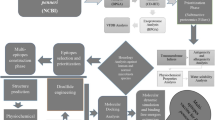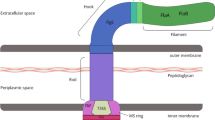Abstract
Yersinia pseudotuberculosis survive no longer than 30 days during periodic culturing in nutrient medium at 37°C. Our experiments demonstrated transformation of these bacteria into resting (nonculturable) forms after one month in culture. Resting cells are more viable than dividing cells and under certain conditons can revert to the initial (proliferative) state.
Similar content being viewed by others
References
L. S. Buzoleva,Ecology of Pathogenic Bacteria [in Russian], Novosibirsk (1994), pp. 144–150.
E. N. Emel'yanenko, M. Yu. Aksenov, A. L. Gintsburg, and V. Yu. Litvin,Pathogenic Bacteria in Communities [in Russian], Moscow (1994), pp. 135–139.
L. E. Korsh and T. Z. Artemova,Rapid Methods for Sanitary Bacteriological Studies [in Russian], Moscow (1978), pp. 110–111.
A. S. Labinskaya,Microbiology and Technique of Microbiological Studies [in Russina], Moscow (1978), pp. 47–53.
K. A. Lusta and B. A. Fikhte,Methods for Evaluating Microorganism Viability [in Russian], Pushchino (1990), pp. 51–52.
G. V. Mukamolova,Formation and Biochemical Characteristics of Resting Forms of Nonsporulating Micrococcus Luteus, Abstract of Cand. Biol. Sci. Dissertation, Moscow (1995).
D. M. Novogrudskii,Microbiology of Soil [in Russian], Alma-Ata (1956), pp. 225–229.
Yu. M. Romanova,Nonculturable State of Pathogenic Bacteria as Exemplified by Salmonella typhimurium: Phenomenon and Genetic Control, Abstract of Doct. Biol. Sci. Dissertation, Moscow (1997).
G. P. Somov,Far-Eastern Scarlatiniform Fever [in Russian], Moscow (1979), p. 31.
G. P. Somov, T. N. Varvashevich, and N. F. Timchenko,Psychrophility of Pathogenic Bacteria [in Russian], Novosibirsk (1991), pp. 26–27.
R. Steinier, E. Edelgerg, and J. Ingram,World of Bacteria [in Russian], Moscow (1979), vol. 2, pp. 40–43.
R. R. Colwell, P. R. Brayton, D. J. Grimes, et al.,Biotechnology,3, 817–820 (1985).
Z. Darzynkiewicz, M Andreeff, and G. Traganos,Exp. Cell. Res.,115, 31–35 (1978).
T. V. Votyakova, A. S. Kaprelyants, and D. B. Kell,Apl. Environ. Microbiol.,60, No. 9, 3284–3291 (1994).
Author information
Authors and Affiliations
Additional information
Translated fromByulleten' Eksperimental'noi Biologii i Meditsiny, Vol. 129, No. 4, pp. 444–447, April, 2000
Rights and permissions
About this article
Cite this article
Buzoleva, L.S. Periodic culturing of nonculturableYersinia pseudotuberculosis forms. Bull Exp Biol Med 129, 374–376 (2000). https://doi.org/10.1007/BF02439275
Received:
Issue Date:
DOI: https://doi.org/10.1007/BF02439275




